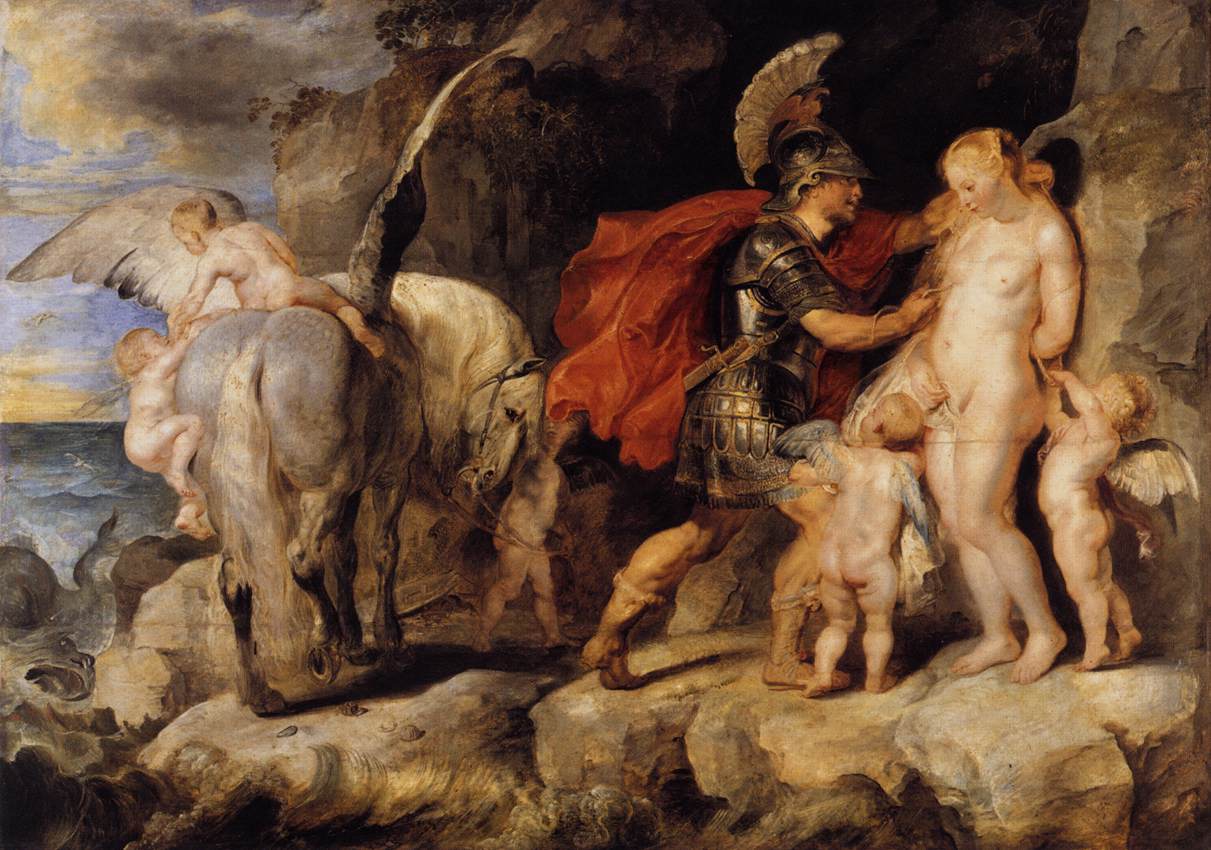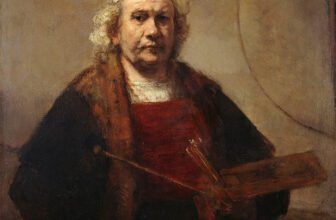
The Myth Behind Perseus Freeing Andromeda Painting
Art has long served as a mirror to mythology, capturing humanity’s greatest tales through color, composition, and emotion. Among the most compelling renditions of classical myth in European painting is Peter Paul Rubens’ Perseus Freeing Andromeda. This Baroque masterpiece brims with drama, sensuality, and heroism, immortalizing a tale of rescue, love, and divine intervention. In the hands of Rubens, one of the greatest painters of the 17th century, the myth of Perseus and Andromeda becomes a dynamic ballet of flesh and motion, light and shadow, power and vulnerability.
This essay explores the rich narrative, symbolism, technique, and enduring relevance of Perseus Freeing Andromeda, offering a deep dive into its creation, meaning, and artistic mastery.
The story of Perseus and Andromeda comes from Greek mythology, specifically from Ovid’s Metamorphoses. Andromeda, the daughter of King Cepheus and Queen Cassiopeia of Ethiopia, was condemned to be sacrificed to a sea monster as punishment for her mother’s vanity. Cassiopeia had boasted that her daughter was more beautiful than the Nereids (sea nymphs), inciting the wrath of Poseidon. Chained to a rock by the sea as an offering, Andromeda awaited her doom, until Perseus, son of Zeus and the mortal Danaë, arrived on his winged sandals.
Having just slain the Gorgon Medusa, Perseus was already a hero. He saw the helpless maiden, fell in love at first sight, and made a deal with her parents: he would save Andromeda if he could claim her as his wife. With the head of Medusa, Perseus turned the sea monster to stone, freeing Andromeda and fulfilling the romantic hero’s arc.
This myth is a timeless tale of love, bravery, and divine retribution. It has captivated artists for centuries, but none captured its sensual intensity and heroic grandeur quite like Rubens.
Peter Paul Rubens and the Baroque Era
To understand Perseus Freeing Andromeda, one must understand Peter Paul Rubens (1577–1640). A Flemish artist, Rubens epitomized the Baroque style, a movement characterized by grandeur, drama, movement, and emotional intensity. Baroque art emerged in the early 17th century as a response to the intellectual coolness of the Renaissance. It sought to overwhelm the senses and stir the soul.
Rubens was more than a painter; he was also a diplomat, humanist, and intellectual. He painted religious scenes, mythological tableaux, and historical epics with unmatched vigor and sensuality. His works pulsate with life, capturing the tension of physical movement and emotional heat. Perseus Freeing Andromeda, painted between 1620 and 1622, exemplifies these qualities in full measure.
What’s Happening in the Painting?
In Perseus Freeing Andromeda, Rubens captures the pivotal moment when Perseus approaches Andromeda, who is chained to the rocks, moments before or after slaying the sea monster. The scene is a climax of narrative tension, packed with energy and emotion.
Andromeda is depicted nude, her arms bound above her head against jagged rocks. Her posture is both vulnerable and graceful, emphasizing her beauty and helplessness. Her gaze often shifts in various versions, sometimes turned away in fear, sometimes cast toward her rescuer.
Perseus, muscular and god-like, is depicted either in mid-action or having just defeated the monster. He is adorned in classical armor, his red cloak fluttering, his winged helmet perched atop his curly hair. At his side often appears Pegasus, the winged horse born from Medusa’s blood, further cementing the mythological context.
In the shadows or at the edges, the grotesque sea monster lurks or lies slain, adding a dynamic element of danger. The contrast between light (focused on the bodies of Perseus and Andromeda) and dark (the sea and the monster) emphasizes salvation and peril, good conquering evil.
Artistic Analysis: Rubens’ Technique and Composition
Rubens’ handling of oil paint is masterful. His use of rich, saturated colors, dynamic brushwork, and luminous skin tones showcases his deep understanding of anatomy, light, and emotion. Several aspects of his technique deserve closer attention:
1. Dramatic Lighting (Chiaroscuro)
Rubens employs chiaroscuro, the Baroque hallmark of using light and shadow to create depth and emotion. The light illuminates the flesh of Andromeda and Perseus, casting the monster and background into shadow. This visual emphasis guides the viewer’s eye directly to the human drama.
2. The Human Body in Motion
Rubens had a fascination with the muscular, dynamic human form, especially the nude body. His training in Italy exposed him to Michelangelo and the antique sculptures of Rome, which influenced his heroic depictions of mythological figures. In Perseus Freeing Andromeda, the twisting torsos, outstretched limbs, and flowing drapery all convey a sense of immediate motion and emotional tension.
3. Color and Flesh
The skin tones Rubens achieves are legendary. Warm and lifelike, they create a tactile realism. Andromeda’s flushed skin stands in stark contrast to the cold, scaly hide of the sea creature. This contrast enhances the tension between human vulnerability and monstrous threat.
4. Emotional Expression
Unlike static Renaissance nudes, Rubens’ figures feel, their expressions are vivid with fear, determination, and passion. Andromeda’s fear and modesty, Perseus’ determination, and even the pathos of the monster’s defeat contribute to the psychological richness of the scene.
Symbolism and Deeper Meaning
At first glance, Perseus Freeing Andromeda is a romantic rescue scene, but beneath the surface lies a world of symbolism, some traditional, others personal or cultural:
1. Rescue as Redemption
Andromeda’s rescue can be interpreted as a metaphor for spiritual or moral salvation. Her nudity, often seen as a symbol of vulnerability or purity, contrasts with the chaos and violence surrounding her. Perseus represents the divine or heroic force that liberates the soul from suffering.
2. Divine Justice
The punishment of Andromeda for her mother’s sin reflects the ancient idea of generational guilt and divine retribution, while her salvation represents mercy and redemption, recurring themes in Baroque art that aligned with Catholic Counter-Reformation ideals.
3. Beauty and the Beast
The painting echoes the eternal tension between beauty and monstrosity, purity and corruption. This duality serves as both an aesthetic and moral allegory. The monstrous sea creature represents chaos and punishment; Andromeda, idealized beauty; Perseus, the righteous agent of order.
4. Heroic Masculinity and Passive Femininity
Some feminist critiques of the painting highlight the gender dynamics: the active, armored male savior and the passive, naked female victim. This reflects societal attitudes of the time, though Rubens often imbued his female figures with agency through expression and posture, even in moments of vulnerability.
5. Triumph of Civilization Over Nature
As with many classical myths, this scene can be interpreted as the triumph of rational, heroic civilization over wild, untamed nature. The sea monster represents the threatening unknown, while Perseus brings order through divine favor and courage.
Where is The Perseus Freeing Andromeda Location
One of the most famous versions of Perseus Freeing Andromeda by Rubens is housed in the Gemäldegalerie (Picture Gallery) in Berlin, Germany. It is part of the collection of the Staatliche Museen zu Berlin, one of the most prestigious museum networks in Europe.
Rubens painted more than one version of the scene (as was common in his studio). Other versions or copies, possibly completed with help from his workshop assistants, exist in various collections, including the Hermitage Museum in St. Petersburg and private collections. The Berlin version is often regarded as the definitive or most artistically significant.
The Painting’s Style: Baroque at Its Peak
Rubens’ Perseus Freeing Andromeda is a quintessential Baroque painting:
Dramatic: Full of action, peril, and emotional climax.
Theatrical: Like a scene from a grand opera.
Naturalistic: Despite its mythological theme, the bodies, light, and textures are hyper-realistic.
Emotional: The viewer is pulled into the emotional drama as a participant, not just a spectator.
Baroque art was meant to move, to make the viewer feel awe, fear, or passion, and Rubens achieves this through every swirl of fabric, every glint of light, every twist of limb.
Why Perseus Freeing Andromeda Still Matters
Peter Paul Rubens’ Perseus Freeing Andromeda remains a stunning example of how art can elevate myth to timeless drama. The painting is not merely a visual recounting of an ancient story, it is an exploration of human emotion, divine intervention, gender roles, beauty, and power. Through his technical brilliance and narrative power, Rubens creates a work that transcends time.
Today, as we revisit classical myths through new lenses, psychological, feminist, philosophical, Rubens’ painting offers fertile ground for reflection. It stands not only as a milestone of Baroque artistry but also as a cultural artifact that invites us to ask: What does it mean to be rescued? What is beauty’s role in power dynamics? And how do we tell stories of suffering, redemption, and love?
In an age of digital saturation and fleeting images, Rubens reminds us of the power of paint, pigment, and passion, to tell stories that never grow old.




